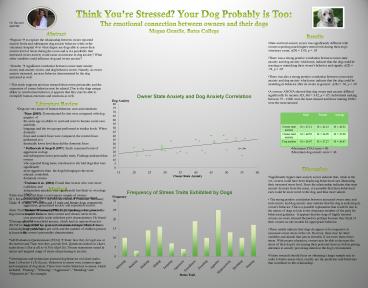Method - PowerPoint PPT Presentation
1 / 1
Title:
Method
Description:
State and trait anxiety scores was significantly different with owners reporting ... There was a strong positive correlation between owner state anxiety and dog ... – PowerPoint PPT presentation
Number of Views:17
Avg rating:3.0/5.0
Title: Method
1
Think Youre Stressed? Your Dog Probably is
Too The emotional connection between owners and
their dogs Megan Gentile, Bates College
Dr. Hazzard and Ellie
- Abstract
- Purpose ? to explore the relationship between
owner reported anxiety levels and subsequent dog
anxiety behavior while at the veterinary hospital
? to what degree are dogs able to assess their
owners level of stress during the exam and is it
a possibility that increased owner anxiety could
cause an increase in dog anxiety? What other
variables could influence dog and owner anxiety? - Results ? significant correlation between owner
state anxiety scores, trait anxiety scores, and
dog behavior scores. Namely, as owner anxiety
increased, anxious behavior demonstrated by the
dog increased as well. - This study supports previous research that owner
personality and the expression of canine behavior
may be related. Due to the dogs unique ability to
read human behavior, it appears that they may be
able to exemplify human emotions and reactions as
well.
Results
- State and trait anxiety scores was significantly
different with owners reporting much higher
stress levels during their dogs veterinary exam,
t(29) 3.05, p lt .05 - There was a strong positive correlation between
owner state anxiety and dog anxiety which may
indicate that the dog could be reacting or
mimicking their owners behavior and signals,
r(28) .78, p lt .05 - There was also a strong positive correlation
between owner trait anxiety and dog anxiety which
may indicate that the dog could be modeling its
behavior after its owner in general , r(28)
.56, p lt .05 - A oneway ANOVA showed that dog owner trait
anxiety differed significantly by income F(3, 36)
3.42, p lt .05. Individuals making between 75
100K were the least stressed and those making
200K were the most stressed
- Literature Review
- Dogs are very aware of human behavior, cues and
emotions - Hare (2005) Domesticated fox kits were compared
with dog puppies of - the same age on ability to read and react to
human social cues and body - language and the two groups performed at similar
levels. When domestic - foxes and control foxes were compared, the
control foxes performed at a - drastically lower level than did the domestic
foxes - Podberscek Serpell (1997) Study examined
levels of aggression in dogs - and subsequent owner personality traits. Findings
indicated that owners - who reported being tense, emotional or shy had
dogs that were significantly - more aggressive than the dogs belonging to the
more relaxed, controlled, - dominant owners.
- Dodman et al. (2004) Found that owners who were
more confident, and - independent minded, were significantly less
likely to own dogs which - developed behavior problems such as dominance
related aggression, fear - aggression, generalized anxiety and separation
anxiety.
- Maximum STAI score 80
- Maximum dog anxiety score 48
Discussion
- Significantly higher state anxiety scores
indicate that, while at the vet, owners could
have been displaying behavioral cues illustrating
their increased stress level. Since the
relationship indicates that state anxiety
deviates from the norm, it is possible that these
behavioral cues could be more novel to the dog,
and thus more salient. - The strong positive correlation between
increased owner state and trait anxiety and dog
anxiety may indicate that the dog is analyzing
its owners behavior. This is a possible
explanation that could be due to the nature of
dogs to look to the dominant member of the pack
for behavioral guidance. It appears that the
dogs of highly stressed owners are more stressed
themselves perhaps because they think of their
owners as role models for appropriate behavior. - These results indicate that dogs do appear to be
responsive to increased owner stress at the vet.
However, there may be other variables and stimuli
that just as stressful, if not more than owner
stress. With proper education, owners may be able
to decrease the stress of their dog by decreasing
their personal stress as well as paying attention
to anxiety provoking stimuli in the dogs
environment. - Future research should focus on obtaining a
larger sample size in order to better assess
what, exactly, are the predictors and behaviors
that contribute to this relationship.
- Method
- Data were collected from a convenience sample of
owners - (N 30) and their dogs (N 30) who are clients
of Falmouth Veterinary Clinic ? 11 men, 19 women
and 15 male and female dogs, respectively. - State Trait Anxiety Inventory by Charles D.
Spielberger was given to the dog owners in order
to assess their current and chronic stress
levels. - Demographics ? household income, which had six
options from low (0-25K) to high (200K),
gender, marital status (Single/Married/ In a
relationship), age, work hours per week and the
number of children present in household. - Self-Evaluation Questionnaire (STAI) ? State
how they feel right now at this moment and Trait
how they generally feel. Questions ranked on
Likert scales from 1 (Not at all) to 4 (Very Much
So). Twenty statements varied in nature and
targeted range of issues all pertaining to
anxiety. - Veterinarians and technicians assessed dog
behavior on Likert scales from 1 (None) to 4 (To
Excess). Behaviors to assess were common signs
and symptoms of dog stress. There were twelve
behaviors to assess, which included, Panting,
Whining, Aggression, Shedding and
Hyperactivity for example.


























![Chapter 3: Simplex methods [Big M method and special cases] PowerPoint PPT Presentation](https://s3.amazonaws.com/images.powershow.com/4471558.th0.jpg?_=202101090310)




